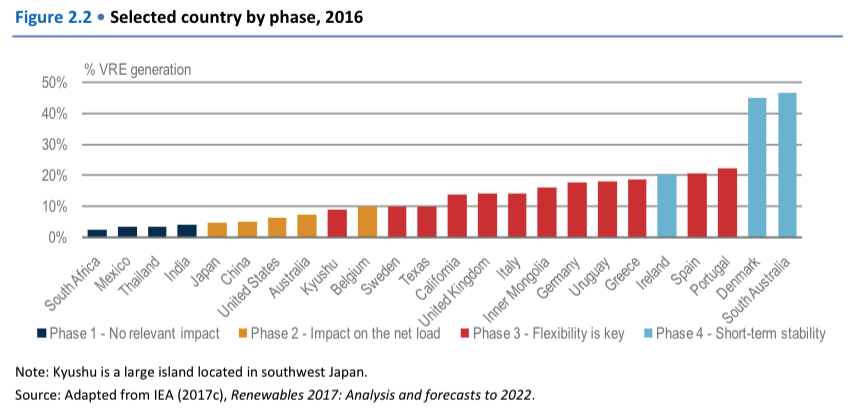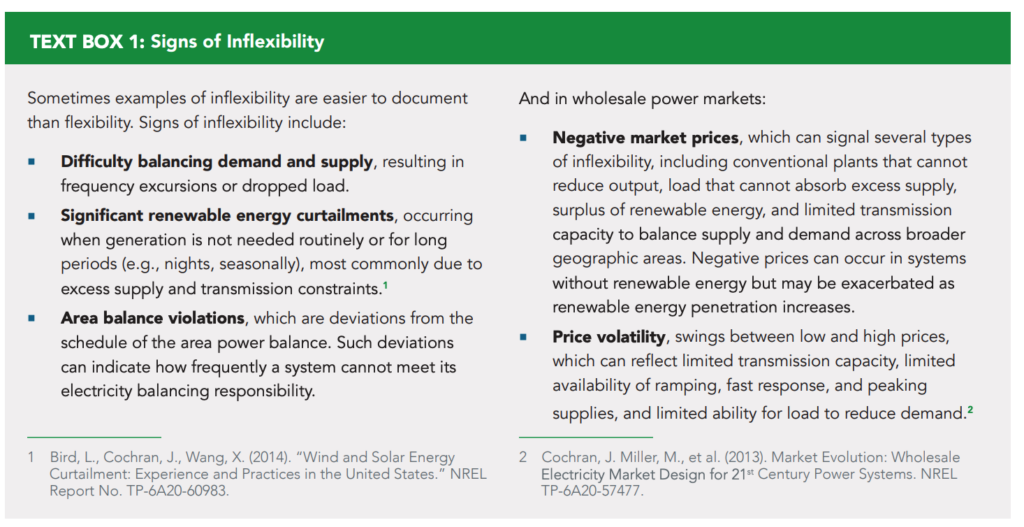Many power systems already have enough flexibility to integrate additional variable renewable energy (VRE), though operational changes may be required to do so. Planning for higher levels of VRE requires assessing the current level of system flexibility and then planning to invest in additional flexibility measures. Assessing system flexibility may involve a range of stakeholders and require significant amounts of data, but may be combined with other power sector planning processes.
Main Points
- Assessing current system flexibility and planning for future flexibility helps power systems successfully integrate higher shares of renewable energy.
- Planning ahead for increased flexibility saves money by avoiding situations where urgent, high-cost flexibility measures are needed to address power system challenges.
- Flexibility assessments range from quick estimates based on existing circumstances to detailed models run on their own or as part of other power sector planning exercises.
First, Read This
The IEA has identified six levels of VRE integration into power systems based on the impact on those systems and the amount of system flexibility required to maintain performance.
It is important to note that low levels of VRE generation (up to around 10%) don’t have much impact on power systems. But as the share of VRE generation increases, different types of flexibility become important.

Read Excerpt: Pages 21 and 22 of Status of Power System Transformation 2018 by IEA and 21CPP. Figure 2.2 on page 22 includes the % of VRE generation for select jurisdictions around the world in 2016. The % of VRE generation for Texas and California was closer to 20 percent VRE in 2016.
Now, Read This
If a power system does not have sufficient flexibility for the level of VRE generation, curtailment of renewable energy, dropped load, frequency excursions, or other challenges may be experienced.

Read Excerpt: Page 4 of Flexibility in 21st Century Power Systems by 21CPP.
And This
It is important to plan for flexibility to avoid system reliability and performance issues. This is easier to do in a power system that is expanding to meet growing demand.

Read Excerpt: Page 35 from Power System Flexibility for the Energy Transition – Part 1 by IRENA.
Next, Read This
There are a number of analytical frameworks for assessing system flexibility, each of which involves its own investment of time and resources.
The 21st Century Power Partnership has divided system flexibility assessments into three types:
Quick Estimates: What types of flexibility does my system have?
- A simple summary of major sources of flexibility, such as capacity levels of dispatchable plants, pumped-hydro storage, demand response, and interconnection to neighboring systems, can provide a snapshot of system flexibility.
First-Cut Analysis Using Time-Series Data
- Will my power system at all hours of the year by technically able to meet demand at a given level of variability and uncertainty (assuming no renewable energy curtailment)?
Flexibility Assessments in the Context of Detailed Power System Planning
- How will increased VRE and dynamic loads impact the operation of my power system, how much more can I incorporate, and what changes can I make to the system, markets, and operations to improve reliability?
Text excerpt from pages 5-8 of 21CPP: Flexibility in 21st Century Power Systems
And This
The IRENA FlexTool is a free, publicly-available power system planning tool that is focused on system flexibility. It highlights possible problems associated with a lack of flexibility and identifies investments to address them.

Read Excerpt: Page 17 of Power System Flexibility for the Energy Transition – Part 2 by IRENA.
Suggested Actions & Next Steps
- Research whether there is renewable energy curtailment or other signs of inflexibility in your system.
- Consider what is needed for different frameworks to assess system flexibility. Do you have what you would need?
- Learn about IRENA’s Flexibility Assessment Tool and think about what you would need to perform the analysis.
- Review these power system flexibility assessment case study for Thailand, or others for Colombia, Panama, or Uruguay.

